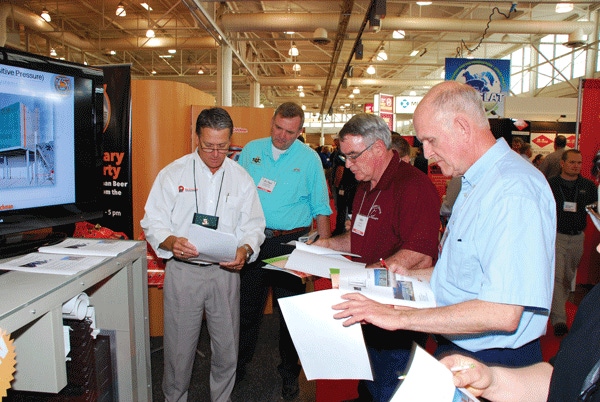It filters out pathogens, helps provide integrated cooling for swine buildings.

Big Dutchman’s AIRPro-Tec PRRS filtration system filters out pathogens, such as the porcine reproductive and respiratory syndrome (PRRS) virus, and helps provide integrated cooling for swine buildings, according to Brian Wolf, business development sales executive, Big Dutchman Inc.
“Each filter module consists of three air-purifying phases,” Wolf explained. “The first phase uses a wind-breaking mesh net to block coarse dirt particles from entering the unit. In the second phase, the air must pass through the actual antimicrobial filter medium that is able to filter out the smallest particles, such as the PRRS virus. Clarcor designed a filter exclusively for Big Dutchman. The final phase consists of the clean air passing through the evaporative plastic cooling pad system, which provides cooling, if necessary.”
Filter units are placed on the outside of the building, and connected by an air duct with a fan and shutter. Filtered air is then blown into the building’s attic. Air is directed into the building or individual rooms through ceiling inlets. An integrated control unit monitors the system and regulates the proper ventilation pressure.
The square filtration units are generally 7.9 ft. wide and high, with a total length, including the connecting duct, of 10.6 ft. Measurements can be altered to fit a producer’s needs. A small service door on the side of the unit allows access inside for maintenance.
Steve Hoff wondered how the units were sealed to prevent leakage of air into buildings. Andreas Kerssens, Big Dutchman engineer, explained: “Before delivery, the modules go through a leakage test, similar to a blower door test used for energy-efficient buildings. Only if the module is absolutely airtight will it receive an official label verifying long-term air tightness, and will then be ready for transport and delivery.”
The panel asked what type of maintenance is necessary with the units. “The control unit ensures the right positive pressure in the attic. If leakage should occur in the module, the farmer will get an alarm to service the unit, so more or less, no maintenance,” Kerssens said. The pre-and main filters should be replaced based on local circumstances and dust and debris buildup, every one to three years. The plastic cooling pad should not have to be replaced, according to Kerssens.
The panel asked about pricing. Kerssens said the price would have to be calculated depending on individual specifications.
Learn more at www.bigdutchmanusa.com.
About the Author(s)
You May Also Like


